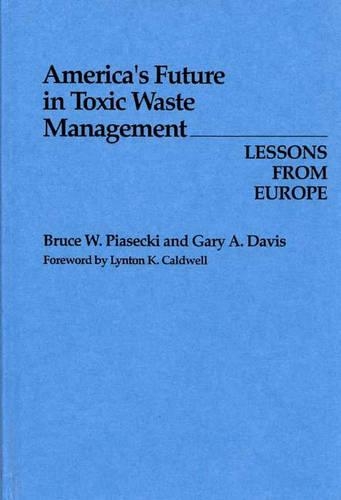
America's Future in Toxic Waste Management: Lessons from Europe
(Hardback)
Publishing Details
America's Future in Toxic Waste Management: Lessons from Europe
By (Author) Gary A. Davis
Bloomsbury Publishing PLC
Praeger Publishers Inc
4th December 1987
United States
Classifications
Tertiary Education
Non Fiction
363.7280973
Physical Properties
Hardback
339
Description
A major contribution to the environmental policy debate, this is the first book to examine the legal, technical, and planning initiatives employed in Europe to avoid land disposal of toxic waste. Although largely ignored in the U.S. until now, safer alternatives to land disposal exist in Europe. By studying and implementing the best of these methods, the authors argue, the United States can begin to resolve its own toxic waste problem, a problem that has reached crisis proportions.
Reviews
. . . it should be read by government and corporate policy makers. It would be a good reader in an advanced course in environmental management.-Zentralblatter/Abstract Journals
A vision of a hazardous waste management system operated by unqualified bin-men' would frighten anyone. Such a scenario is portrayed as prevalent in America. The accuracy of this picture is uncertain but, in general, this work appears well researched and is moderately readable and ideal for anyone with a strong interest in the issues discussed. Europe is heralded as a role model for America and the three pivotal factors of European management (co-operation, fundamental policy changes and distrust of land disposal methods) are discussed in great depth, accompanied by copious references. Topics range from the problems of ocean incineration to waste reduction techniques, while the emphasis is continually placed on how European strategies would benefit American waste disposal planners. . . . The extensive appendices and bibliographies are perfect for those scholars and planners who are stimulated by this critical study.-International Journal of Environmental Education and Information
This collection of ten essays offers a cross-cultural study of hazardous waste management issues in the hope that we may thereby better reform environmental management in the United States. Contents include: Restructuring Toxic Waste Controls: Intrinsic Difficulties and Historical Trends, ' by Piasecki and Davis. Part I: Minimizing Risks through Technology: Waste Reduction Strategies: European Practice and American Prospects, ' by Davis, Donald Huisingh, and Piasecki; Shifting the Burden Off the Land: The Role of Technical Innovations, ' by Davis; and Alternatives to Ocean Incineration in Europe, ' by Piasecki and Hans Sutter. Part 2: Government Control of Risk: Government Ownership of Risk: Guaranteeing a Treatment Infrasture, ' by Davis and Joanne Linnerooth, with Piasecki; Making Waste Recoverable: European Waste Oil Programs; by Lee Breckenridge; Waste Havens and Waste Transfers: International Transboundary Issues, ' by Piasecki and Wendy Grieder. Part 3: The Challenge Ahead: Siting Hazardous Waste Facilities: Asking the Right Questions, ' by Davis and William Colglazier; Government's Aid: The Role of Citizen and Environmental Groups in Europe, ' by Piasecki and Janet Brooks; and Establishing Collection Systems: Benefits of the Infrastructure Approach, ' by Piasecki and Stuart Messinger. Concluding Remarks: The Next Steps After Land Disposal, ' by Davis and Piasecki.-Science, Technology and Society
." . . it should be read by government and corporate policy makers. It would be a good reader in an advanced course in environmental management."-Zentralblatter/Abstract Journals
"A vision of a hazardous waste management system operated by unqualified bin-men' would frighten anyone. Such a scenario is portrayed as prevalent in America. The accuracy of this picture is uncertain but, in general, this work appears well researched and is moderately readable and ideal for anyone with a strong interest in the issues discussed. Europe is heralded as a role model for America and the three pivotal factors of European management (co-operation, fundamental policy changes and distrust of land disposal methods) are discussed in great depth, accompanied by copious references. Topics range from the problems of ocean incineration to waste reduction techniques, while the emphasis is continually placed on how European strategies would benefit American waste disposal planners. . . . The extensive appendices and bibliographies are perfect for those scholars and planners who are stimulated by this critical study."-International Journal of Environmental Education and Information
"This collection of ten essays offers a cross-cultural study of hazardous waste management issues in the hope that we may thereby better reform environmental management in the United States. Contents include: Restructuring Toxic Waste Controls: Intrinsic Difficulties and Historical Trends, ' by Piasecki and Davis. Part I: Minimizing Risks through Technology: Waste Reduction Strategies: European Practice and American Prospects, ' by Davis, Donald Huisingh, and Piasecki; Shifting the Burden Off the Land: The Role of Technical Innovations, ' by Davis; and Alternatives to Ocean Incineration in Europe, ' by Piasecki and Hans Sutter. Part 2: Government Control of Risk: Government Ownership of Risk: Guaranteeing a Treatment Infrasture, ' by Davis and Joanne Linnerooth, with Piasecki; Making Waste Recoverable: European Waste Oil Programs; by Lee Breckenridge; Waste Havens and Waste Transfers: International Transboundary Issues, ' by Piasecki and Wendy Grieder. Part 3: The Challenge Ahead: Siting Hazardous Waste Facilities: Asking the Right Questions, ' by Davis and William Colglazier; Government's Aid: The Role of Citizen and Environmental Groups in Europe, ' by Piasecki and Janet Brooks; and Establishing Collection Systems: Benefits of the Infrastructure Approach, ' by Piasecki and Stuart Messinger. Concluding Remarks: The Next Steps After Land Disposal, ' by Davis and Piasecki."-Science, Technology and Society
Author Bio
BRUCE W. PIASECKI is Associate Director of the Hazardous Waste and Toxic Substances Research and Management Center at Clarkson University, where he is also a professor in the Center for Liberal Studies. GARY A. DAVIS is Research Associate at the University of Tennessee's Center for Energy, Resources, and the Environment, where he is affiliated with the Waste Management Research and Education Institute.
